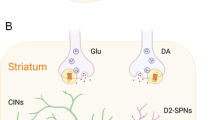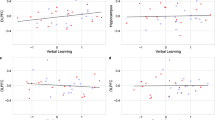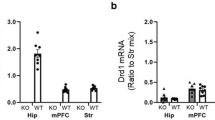Abstract
Phenotypes were assessed topographically in mice lacking functional D2 dopamine receptors [‘knockouts’], using an ethologically based approach to assess all behaviours in the natural repertoire. D2-null mice evidenced an ethogram characterised initially by modest reductions in locomotion and shifts in rearing topographies. Subsequently, topographies of behaviour habituated similarly for wildtypes and ‘knockouts’. Following challenge with the D2-like agonist RU 24213, both inhibition of rearing at a lower dose and induction of stereotyped sniffing and ponderous locomotion at higher doses were essentially absent in D2-null mice. Following challenge with the D1-like agonist A 68930, vacuous chewing was released in D2-null mice. This topographical approach to phenotypic characterisation implicates: (i) the D2 receptor in these D2-like agonist effects and in oppositional D1-like: D2-like interactions; and (ii) the operation of material compensatory processes consequent to the developmental absence of D2 receptors which are able to maintain ethological function under tonic, ‘naturalistic’ conditions but not under ‘phasic’ challenge.
Similar content being viewed by others
Log in or create a free account to read this content
Gain free access to this article, as well as selected content from this journal and more on nature.com
or
References
Baik Ja-H, Picetti R, Salardi A, Thiriet G, Dierich A, Depaulis A, Le Meur M, Borrelli E . (1995): Parkinsonian-like locomotor impairment in mice lacking dopamine D2 receptors. Nature 377: 424–428
Boulay D, Depoortere R, Perrault GH, Borrelli E, Sanger DJ . (1999a): Dopamine D2 receptor knock-out mice are insensitive to the hypolocomotor and hypothermic effects of dopamine D2/D3 receptor agonists. Neuropharmacology 38: 1389–1396
Boulay D, Depoortere R, Rostene W, Perrault G, Sanger DJ . (1999b): Dopamine D3 receptor agonists produce similar decreases in body temperature and locomotor activity in D3 knock-out and wild-type mice. Neuropharmacology 38: 555–565
Boulay D, Depoortere R, Oblin A, Sanger DJ, Schoemaker H, Perrault G . (2000): Haloperidol-induced catalepsy is absent in dopamine D2, but maintained in dopamine D3 receptor knockout mice. Eur J Pharmacol 391: 63–73
Bunzow JR, Van Tol HHM, Grandy DK, Albert P, Salon J, Macdonald C, Machida CA, Neve KA, Civelli O . (1988): Cloning and expression of a rat D2 dopamine receptor cDNA. Nature 336: 783–787
Claudi F, Cardellini M, Di Stefano A, Giorgioni G, Cantalamessa F, Reno F, Balduini W . (1994): Activity of N-(2-phenylethyl)-N-n-propyl-2-(3-hydroxyphenyl) ethylamine derivatives as dopamine receptor ligands. Drug Des Discov 11: 115–125
Clifford JJ, Waddington JL . (1998): Heterogeneity of behavioural profile between three new putative selective D3 dopamine receptor antagonists using an ethologically based approach. Psychopharmacology 136: 284–290
Clifford JJ, Tighe O, Croke DT, Drago J, Sibley DR, Waddington JL . (1998): Topographical evaluation of the phenotype of spontaneous behaviour in mice with targeted gene deletion of the D1A dopamine receptor: Paradoxical elevation of grooming syntax. Neuropharmacology 37: 1595–1602
Clifford JJ, Tighe O, Croke DT, Kinsella A, Sibley DR, Drago J, Waddington JL . (1999): Conservation of behavioural topography to dopamine D1-like receptor agonists in mutant mice lacking the D1A receptor implicates a D1-like receptor not coupled to adenylyl cyclase. Neuroscience 93: 1483–1489
Clifford JJ, Usiello A, Vallone D, Kinsella A, Borrelli E, Waddington JL . (2000): Topographical evaluation of behavioural phenotype in a line of mice with targeted gene deletion of the D2 dopamine receptor. Neuropharmacology 39: 382–391
Crabbe JC, Wahlsten D, Dudek BC . (1999): Genetics of mouse behaviour: Interactions with laboratory environment. Science 284: 1670–1673
Crawley JN . (1999): Behavioural phenotyping of transgenic and knockout mice: Experimental design and evaluation of general health, sensory functions, motor abilities and specific behavioural tests. Brain Res 835: 18–26
Daly SA, Waddington JL . (1993): Behavioural evidence for “D-1-like” dopamine receptor subtypes in rat brain using the new isochroman agonist A 68930 and isoquinoline antagonist BW 737C. Psychopharmacology 113: 45–50
DeNinno MP, Schoenleber R, MacKenzie R, Britton DR, Asin KE, Briggs C, Trugman JM, Ackerman M, Artman L, Bednarz L, Bhatt R, Curzon P, Gomez E, Kang CH, Stittsworth J, Kebabian JW . (1991): A 68930: A potent agonist selective for the dopamine D1 receptor. Eur J Pharmacol 199: 209–219
Euvrard C, Ferland L, Dipaolo T, Beaulieu M, Labrie F, Oberlander C, Raynaud JP, Boissier JR . (1980): Activity of two new potent dopaminergic agonists at the striatal and anterior pituitary levels. Neuropharmacology 19: 379–386
Gerlai R . (1999): Targeting genes associated with mammalian behaviour: Past mistakes and future solutions. In Crusio WE, Gerlai RT (eds), Techniques in the Behavioral and Neural Sciences. Amsterdam, Elsevier, pp 381–392
Giros B, Sokoloff P, Martres M-P, Riou J-F, Emorine LJ, Schwartz J-C . (1989): Alternative splicing directs the expression of two D2 receptor isoforms. Nature 342: 923–925
Jung M-Y, Skryabin BV, Arai M, Abbondanzo S, Fu D, Brosius J, Robakis NK, Polites HG, Pintar JE, Schmauss C . (1999): Potentiation of the D2 mutant motor phenotype in mice lacking dopamine D2 and D3 receptors. Neuroscience 91: 911–924
Kelly MA, Rubinstein M, Asa SL, Zhang G, Saez C, Bunzow JR, Allen RG, Hnasko R, Ben-Jonathan N, Grandy DK, Low MJ . (1997): Pituitary lactotroph hyperplasia and chronic hyperprolactinaemia in dopamine D2 receptor-deficient mice. Neuron 19: 103–113
Kelly MA, Rubinstein M, Phillips TJ, Lessov CN, Burkhart-Kasch S, Zhang G, Bunzow JR, Fang Y, Gerhardt A, Grandy DK, Low MJ . (1998): Locomotor activity in D2 dopamine receptor-deficient mice is determined by gene dosage, genetic background, and developmental adaptions. J Neurosci 18: 3470–3479
Koeltzow TE, Xu M, Cooper DC, Hu XT, Tonegawa S, Wolf ME, White FJ . (1998): Alterations in dopamine release but not dopamine autoreceptor function in dopamine D3 receptor mutant mice. J Neurosci 18: 2231–2238
Levant B . (1997): The D3 dopamine receptor: neurobiology and potential clinical relevance. Pharmacol Rev 49: 231–252
L'hirondel M, Cheramy A, Godeheu G, Artaud F, Saiardi A, Borrelli E, Glowinski J . (1998): Lack of autoreceptor-mediated inhibitory control of dopamine release in striatal synaptosomes of D2 receptor-deficient mice. Brain Res 792: 253–262
McNamara FN, Clifford JJ, Kinsella A, Fuchs S, Drago J, Rubinstein M, Grandy DK, Low MJ, Croke DT, Waddington JL . (2000): Topographical specification of behavioural phenotype in dopamine D2−/− vs. D3−/− knockout mice. Soc Neurosci Abstr 26: 1766
McNamara F, Clifford J, Kinsella A, Drago J, Croke D, Waddington J . (2001): Topographical assessment of behavioural phenotype in congenic dopamine D1A receptor ‘knockout’ mice. Brit J Pharmacol, In Press.
Mercuri NB, Saiardi A, Bonci A, Picetti R, Calabresi P, Bernardi G, Borrelli E . (1997): Loss of autoreceptor function in dopaminergic neurons from dopamine D2 receptor deficient mice. Neuroscience 79: 323–327
Missale C, Nash SR, Robinson SW, Jaber M, Caron MG . (1998): Dopamine receptors: From structure to function. Physiol Rev 78: 189–225
Picciotto MR . (1999): ‘Knockout’ mouse models used to study neurobiological systems. Curr Rev Neurobiol 13: 103–149
Sibley DR . (1999): New insights into dopaminergic receptor function using antisense and genetically altered animals. Ann Rev Pharmacol Toxicol 39: 313–341
Sokoloff P, Giros B, Martres MP, Bouthenet ML, Schwartz JC . (1990): Molecular cloning and characterisation of a novel dopamine receptor (D3) as a target for neuroleptics. Nature 347: 146–151
Van Tol HHM, Bunzow J, Guan HC, Sunahara R, Seeman P, Niznik H, Civelli O . (1991): Cloning the gene for a human dopamine D4 receptor with high affinity for the antipsychotic clozapine. Nature 350: 610–614
Waddington JL, Daly SA, McCauley PG, O'Boyle KM . (1994): Levels of functional interaction between D1-like and D2-like dopamine receptor systems. In Niznik HB (ed), Dopamine Receptors and Transporters. New York, Marcel Dekker, pp 513–518
Waddington JL, Daly SA, Downes RP, Deveney AM, McCauley PG, O'Boyle KM . (1995): Behavioural pharmacology of ‘D1-like’ dopamine receptors: Further subtyping, new pharmacological probes and interactions with ‘D2-like’ receptors. Prog Neuro-Psychopharmacol Biol Psychiatry 19: 811–831
Waddington JL, Deveney AM, Clifford JJ, Tighe O, Croke DT, Sibley DR, Drago J . (1998): D1-like dopamine receptors: Regulation of psychomotor behaviour, D1-like: D2-like interactions and effects of D1A targeted gene deletion. In Jenner P, Demirdamar R (eds), Dopamine Receptor Subtypes. Amsterdam, IOS Press, pp 45–53
Waddington JL, Clifford JJ, McNamara FN, Tomiyama K, Koshikawa N, Croke DT . (2001): The psychopharmacology-molecular biology interface: Exploring the behavioural roles of dopamine receptor subtypes using targeted gene deletion [‘knockout’]. Prog Neuro-Psychopharmacol Biol Psychiatry 25: 925–964
Xu M, Koeltzow TE, Santiago GT, Moratalla R, Cooper DC, Hu X-T, White NM, Graybiel AM, White FJ, Tonegawa S . (1997): Dopamine D3 receptor mutant mice exhibit increased behavioral sensitivity to concurrent stimulation of D1 and D2 receptors. Neuron 19: 837–848
Xu M, Koeltzow TE, Cooper DC, Tonegawa S, White FJ . (1999): Dopamine D3 receptor mutant and wildtype mice exhibit identical responses to putative D3 receptor-selective agonists and antagonists. Synapse 31: 210–215
Acknowledgements
These studies were supported by the Higher Education Authority of Ireland, a Galen Research Fellowship from the Irish Brain Research Foundation, and the Research Committee of the Royal College of Surgeons in Ireland [JJC and JLW], and by DA12062 [DKG]. We thank Abbott for A 68930 and Hoechst-Marion-Roussel for RU 24213.
Author information
Authors and Affiliations
Rights and permissions
About this article
Cite this article
Clifford, J., Kinsella, A., Tighe, O. et al. Comparative, Topographically-Based Evaluation of Behavioural Phenotype and Specification of D1-Like:D2 Interactions in a Line of Incipient Congenic Mice with D2 Dopamine Receptor ‘Knockout’. Neuropsychopharmacol 25, 527–536 (2001). https://doi.org/10.1016/S0893-133X(01)00246-9
Received:
Revised:
Accepted:
Published:
Issue date:
DOI: https://doi.org/10.1016/S0893-133X(01)00246-9
Keywords
This article is cited by
-
Dopaminergic Modulation of Forced Running Performance in Adolescent Rats: Role of Striatal D1 and Extra-striatal D2 Dopamine Receptors
Molecular Neurobiology (2021)
-
Inducible ablation of dopamine D2 receptors in adult mice impairs locomotion, motor skill learning and leads to severe parkinsonism
Molecular Psychiatry (2017)
-
Phenotypic studies on dopamine receptor subtype and associated signal transduction mutants: insights and challenges from 10 years at the psychopharmacology–molecular biology interface
Psychopharmacology (2005)
-
Congenic D1A Dopamine Receptor Mutants: Ethologically Based Resolution of Behavioural Topography Indicates Genetic Background as a Determinant of Knockout Phenotype
Neuropsychopharmacology (2003)
-
Topographical Assessment of Ethological and Dopamine Receptor Agonist-Induced Behavioral Phenotype in Mutants with Congenic DARPP-32 ‘Knockout’
Neuropsychopharmacology (2003)



